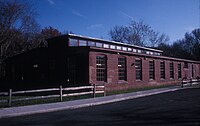Eli Whitney Museum
|
Eli Whitney Gun Factory
|
|

1827 painting of the Gun Factory by William Giles Munson
|
|
| Location | 915-940 Whitney Ave., Hamden, Connecticut |
|---|---|
| Coordinates | 41°20′09″N 72°54′38″W / 41.33583°N 72.91056°WCoordinates: 41°20′09″N 72°54′38″W / 41.33583°N 72.91056°W |
| Area | 9.9 acres (4.0 ha) |
| Built | 1798 |
| NRHP Reference # | 74002049 |
| Added to NRHP | August 13, 1974 |
 |
|
| Established | 1979 |
|---|---|
| Location | Hamden, Connecticut |
| Director | William Brown |
| Website | www.eliwhitney.org |
The Eli Whitney Museum, in Hamden, Connecticut, is an experimental learning workshop for students, teachers, and families. The museum's main building was originally the Eli Whitney Armory, a gun factory erected by Eli Whitney in 1798. The museum focuses on teaching experiments that are the roots of design and invention, featuring hands-on building projects and exhibits on Whitney and A. C. Gilbert.
The museum building was originally the Eli Whitney Armory, erected by Whitney to produce muskets on a site he purchased on September 17, 1798. The factory was powered by water from the Mill River and produced muskets for the United States government. On June 14, 1798, he contracted to produce 10,000 muskets to be delivered within 28 months at the cost of $134,000.00; in fact, it took ten years. When he signed the contract, Whitney had no factory, no workers and no experience in gun manufacturing. However, in a letter to Secretary of the Treasury Oliver Wolcott, a fellow Yale University graduate and friend, Whitney had written:
Whitney's factory was at the very forefront of the American Industrial Revolution, using water-powered machinery, and it was among the first to have standardized, interchangeable parts (for some but not all of its parts).
The area around the museum was once known as Whitneyville, the manufacturing village constructed along the Mill River to house the workers at the Whitney Armory, and made famous by painter William Giles Munson, who sketched the Armory in 1826, a year after Whitney died, creating at least 3 paintings from those sketches over the next two decades. The grounds still feature the old barn, stone coal shed and boarding house which date back to the days of Whitneyville and the operational armory, along with a reconstruction of Ithiel Town's innovative lattice truss covered bridge erected on the original pilings of one of the two bridges built to service the Eli Whitney Armory.
...
Wikipedia


